British and European Car Spotters Guide - 1953 |
|
|
 |
|
|
|
For the first time since the war the British motoring public could go to the Earls Court Motor Show-October 1952-to view the models for the coming year with the feeling that it was once again meant for them as well as their overseas contemporaries. Although, of course, the export markets conntinued to be uppermost in the minds of manuufacturers there was an atmosphere of real optimism that the home-based buyer was at least going to get a look in.
The awareness of new competition both at home and abroad was reflected in the number of quite new models available from British manufacturers which included the Allard Palm Beach, Armstrong Siddeley Sapphire, Austin-Healey 100, Bentley Continental, Sunbeam Alpine and Wolseley Four-Forty Four. Some remarkably high speeds were recorded by a number of British models during the year, albeit in modified form, including an Austin-Healey 100 which clocked 142·6 mph and a Jaguar XK120 topping 174 mph! The total number of cars produced in the UK in 1953 was a record 594,808. Of these more than half were exported, namely 307,368. Just over 2000 cars were imported and the total of new car registrations was 306,483 (including 5129 hackneys). |
 |
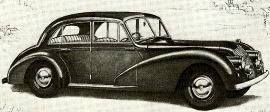 |
 |
AC 2-liter four-door Saloon |
| |
Also see: AC Car Reviews | The History of AC (AUS Edition) |
| |
The AC 2-liter four-door Saloon was introduced on the British market in October 1952. It was similar to the two-door version (from 1947) but fitted with narrower doors hung from the centre pillar. The 1991-cc triple-carburetor engine developed 76 bhp at 4500 rpm. The two-door model was discontinued in 1956. the four-door in 1958. |
|
 |
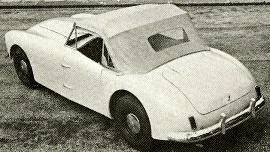 |
 |
Allard Palm Beach Tourer |
| |
Also see: Allard Car Reviews | The History of Allard |
| |
The Allard Palm Beach Tourer was an Open three-seater sports model available with either a Ford Consul 1508-cc Four (Type 21 C) or a Ford Zephyr 2622-cc Six (Type 21 Z) power unit. Fitted with fully-enveloping bodywork. this model was something entirely new for the Allard company which had. since its inception. favored powerful V8 engines for their high-performance cars. Wheelbase was 96 in and weight (dry) was 1800 Ib (21 C) or 1900 Ib (21 Z). |
|
 |
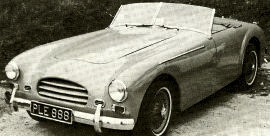 |
 |
Allard K3 Tourer V8 |
| |
Also see: Allard Car Reviews | The History of Allard |
| |
The Allard K3 Tourer was fitted with Ford V8 3622-cc 95-bhp power unit as standard. but also available with Lincoln. Cadillac or Chrysler V8 engine at customers' request, this full-width bodied grand tourer was launched-mainly for export-in October 1952. replaci ng the 1950 - 1952 Model K2. A somewhat later model is shown. |
|
 |
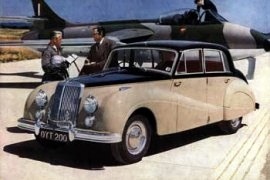 |
 |
Armstrong Siddeley Sapphire |
| |
Also see: The History of Armstrong Siddeley |
| |
The Armstrong Siddeley Sapphire 346 Saloon was available with either a four or six-light body, this luxuriously furnished five/six-seater featured a six-cylinder 3·4-liter 120-bhp engine, a four-speed synchromesh or electrically-operated preselector gearbox, coil spring and wishbone independent front suspension (IFS), a built-in heating/demisting and air-conditioning system, fog lamps and a reversing lamp. The two body styles-identical except for the window arrangements-had long sweeping front wings running to meet fully-spatted rear wings, yet retained the traditional radiator grille. The earlier Whitley and Hurricane models were continued. |
|
 |
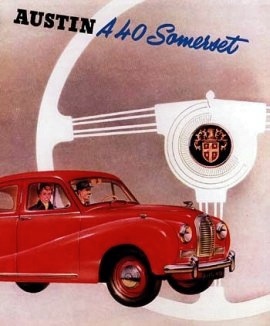 |
 |
Austin A40 Somerset |
| |
Also see: Austin Car Reviews | The History of Austin (AUS Edition) |
| |
The Austin A40 Somerset replaced the A40 Devon and was quite similar to the body-on-frame car, including using the same 1.2 liter straight-4 pushrod engine. The engine was updated to produce 42 hp (31 kW), however giving the car a top speed of 69 mph (111 km/h). The Somerset featured an updated "Transatlantic" body style designed for export and resembled the larger A70 Hereford. It had a bench front seat and column mounted gear change. The Somerset was initially only a 4-door saloon, though a 3-passenger 2-door convertible model made by Carbodies of Coventry was also sold later. The 2-door and convertible differed from the 4-door cars in having separate front seats that folded forwards to give access to the rear. The Austin Motor Company in 1953 made a "special" version of around 500 Somerset saloons with a more powerful engine, different interior appointments and two tone paintwork. The Austin Somerset special had a top speed of 74 mph (119 km/h) while the normal saloon could reach up to 70 mph (110 km/h). Over 173,000 were sold before the Somerset was replaced by the A40 Cambridge in 1954. 7243 of them were convertibles. |
|
 |
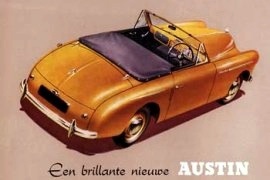 |
 |
Austin A40 Convertible |
| |
Also see: Austin Car Reviews | The History of Austin (AUS Edition) |
| |
A convertible version tested by The Motor magazine in 1953 had a top speed of 74 mph (119 km/h) and could accelerate from 0-60 mph (97 km/h) in 28.6 seconds. A fuel consumption of 30.1 miles per imperial gallon (9.38 L/100 km; 25.1 mpg-US) was recorded. The test car cost £705 including taxes. These figures were all obtained on the contemporary low octane fuel. |
|
 |
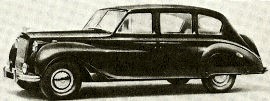 |
 |
Austin A135 Princess Model DM4 Limousine |
| |
Also see: Austin Car Reviews | The History of Austin (AUS Edition) |
| |
The Austin A135 Princess, Model DM4 Limousine was a long-wheelbase model, and was introduced in October 1952. This Vanden Plas coachbuilt model was an addition to the 3·9-liter engined saloon and touring limousine (from 1948) - and had an overall length some 20 in greater than the other two models and had seating for nine. The chassis was used also for special bodywork, e.g. ambulances and hearses. |
|
 |
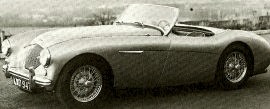 |
 |
|
| |
Also see: Austin Healey Car Reviews |
| |
The Austin-Healey 100, Model BN1, was powered by a 2660-cc, 90-bhp four-cylinder engine. This very attractive, sleek two-seater went on show to the general public on the Healey stand at the 1952 Earls Court Motor Show and was designated the Healey Hundred. The demand completely swamped the Donald Healey Motor Company Ltd, to the extent that the Austin Motor Co. offered to take over the manufacture of the car. By the end of the show, the Healey Hundred had become the Austin-Healey 100. Production commenced in 1953 and was continued until mid-1956 when the car was superseded by the 100 Six. From October 1954 a special export model - the 100S - was available, followed in October 1955 by the 100M which featured a LeMans engine modification kit. |
|
 |
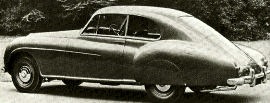 |
 |
|
| |
Also see: Bentley Car Reviews | The History of Bentley |
| |
The Bentley Continental Sports Saloon was an entirely new variant with light-alloy bodywork by H. J. Mulllner. Based on the chassis of the Mark VI Saloon (apart from a higher engine compression ratio and higher final drive ratio) this two-door four-seater had a lower body with long rear wings and sloping 'fastback' rear end styling. It was powered by a modified version of the larger 4566-cc engine, introduced the previous year, which greatly improved the performance and power output. The traditional dummy filler cap and winged 'B' mascot were eliminated from the radiator shell. |
|
 |
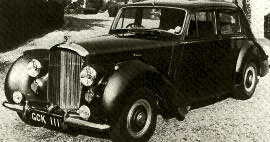 |
 |
Bentley R Type Saloon |
| |
Also see: Bentley Car Reviews | The History of Bentley |
| |
The Bentley R Type Saloon was also known as the B7. This four-door model differed from the Mark VI Saloon mainly in having a lengthened and more elegant tail with the spare wheel housed in a tray under the larger boot. |
|
 |
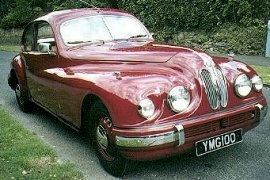 |
 |
|
| |
Also see: Bristol Car Reviews |
| |
The Bristol 403 Saloon was introduced in May 1953, and was identical in appearance to the 401, except for a silver grille, red medallions and the 403 scipt on the sides of the bodywork. In addition, the 1971-cc engine produced more power (100 bhp at 5400 rpm), the braking was improved and a front anti-roll bar was fitted, The Bristol 401/403 has long been regarded by many as one of the most beautiful British cars ever made. |
|
 |
 |
 |
Citroen Big Fifteen Saloon |
| |
Also see: Citroen Car Reviews | The History of Citroen (AUS Edition) |
| |
The Citroen Big Fifteen Saloon was one of the popular front-wheel-drive cars of French origin, although it was assembled in England at Slough, Bucks. Development of a pre-war favorite, this version was re-introduced in October 1952 (it had originally been re-introduced in France in 1947). Fitted with the same engine as the Light Fifteen Saloon 1911-cc. developing 55·7 bhp at 4250 rpm - the Big Fifteen had the same wheelbase and main body shell of the six-cylinder 2·8-liter model (1948-55). |
|
 |
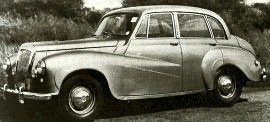 |
 |
|
| |
Also see: Daimler Car Reviews | The History of Daimler (AUS Edition) |
| |
The Daimler Conquest Series DJ Saloon was a replacement for the Consort. This six-seater model used main body pressings identical to those of the Lanchester 14. The new 2·4-liter engine which produced 75 bhp at 4000 rpm gave the Conquest sporting performance and handling, although from the point of view of styling and finish it was very much in the Daimler tradition. |
|
 |
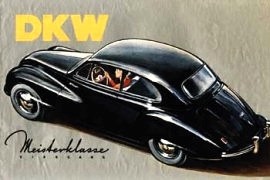 |
 |
DKW F91 Meisterklasse |
| |
Also see: The History of DKW - Deutsche Kraftfarzeug Werke (AUS Edition) |
| |
The DKW F91 was manufactured in Dusseldorf from March 1953 to September 1955 DKW. Tje F91 was powered by a three-cylinder engine (897cc, 34hp), transversely mounted. Other innovations were a column shift and angled telescopic shock absorbers. Externally the F91 was different from its predecessor by a more elegant grille with only five instead of nine cross bars, and run as a four-seat coupe with rear panoramic window. The coupe had fully retractable side windows front and rear, no B-pillar. |
|
 |
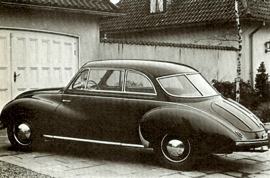 |
|
 |
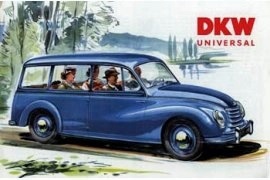 |
|
 |
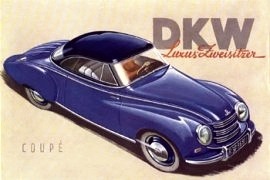 |
|
 |
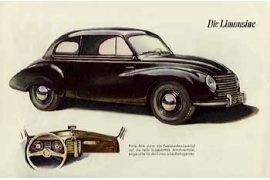 |
|
 |
|
|
 |
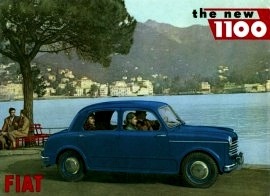 |
 |
Fiat 1100 |
| |
Also see: Fiat Car Reviews | The History of Fiat |
| |
In 1953 the 1100 was completely redesigned as a compact 4-door sedan, with a modern monocoque bodywork and integrated front lights. The new model was called the 1100/103 after its project number, and was offered (as usual at that time) in two different versions: "economica" (cheaper) and "normale" (standard). The car became available in a sporty version, the 1100TV with a third light in the middle of the grille and in station-wagon version, with a side-hinged fifth door at the back. |
|
 |
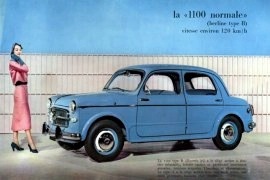 |
|
 |
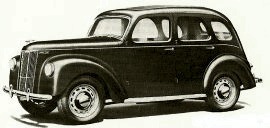 |
 |
Ford Prefect Model E493A and Anglia Model E494 |
| |
Also see: Ford UK Car Reviews | The History of Ford |
| |
The Ford Prefect Model E493A and the smaller two-door Anglia Model E494 were in their last year of production; they were superseded by the New Prefect and New Anglia 100E in October. An economy version of the Anglia, with the old type Prefect engine, was however kept in production, designated the Popular 103E. |
|
 |
 |
 |
Frazer-Nash Targa Florio Turismo |
| |
Also see: The History of Frazer-Nash |
| |
The Frazer-Nash Targa Florio Turismo was a high-speed touring car with entirely new full-width body styling. The windscreen. although not shown. was similar to that of the Mille Miglia model. Named after the famous race because a Frazer-Nash. in 1951 became the first British car to win this event. Also available to full competition specification-Gran Sport-including bucket seats and more powerful engine. |
|
 |
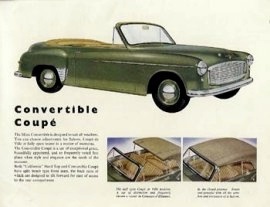 |
|
 |
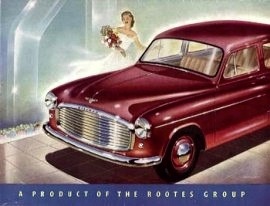 |
|
 |
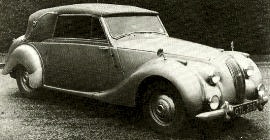 |
 |
Lagonda 2½-liter Saloon and Drophead Coupe |
| |
Also see: The History of Lagonda |
| |
The Lagonda 2½-liter Saloon and Drophead Coupe were six-cylinder-engined luxury cars with all-independent suspension, first announced in 1946. Although retaining the general lines of previous models, the Mark II Saloon (from October 1952) had a smoother and altogether tidier appearance and featured a number of notable improvements including repositioning of components beneath the bonnet to improve accessibility, revised instrument panel, wider rear seat, improved heating and demisting equipment and hydraulic jacks, The Saloon was discontinued in June 1953, the Mark I Coupe (bodied by Tickford) two months later. During the year a few Coupes were produced to Mark II specification. |
|
 |
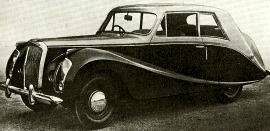 |
 |
Lanchester Dauphin Prototype |
| |
Also see: The History of Lanchester |
| |
The Lanchester Dauphin prototype Saloon, Model LJ250. was a two-door Hooper-bodied model with 2433-cc twin-carb engine and light alloy bodywork. It was not made in quantity. |
|
 |
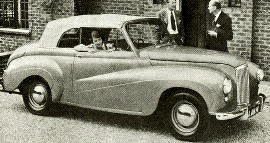 |
 |
Lanchester Fourteen Drophead Coupe |
| |
Also see: The History of Lanchester |
| |
The Lanchester Fourteen Drophead Coupe was based on the Saloon. This two-door 'De Ville Convertible' model. featured a part-power-operated top as standard and had a dry weight some 84 Ib higher than the saloon, Both models were discontinued in the summer of 1954. |
|
 |
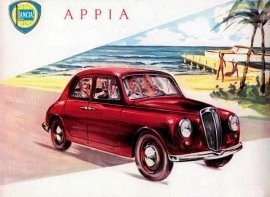 |
|
 |
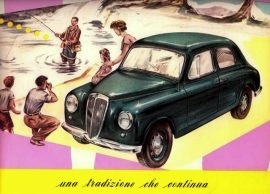 |
|
 |
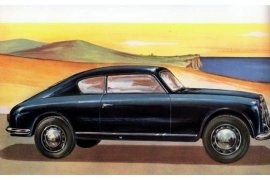 |
|
 |
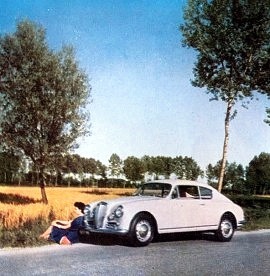 |
|
 |
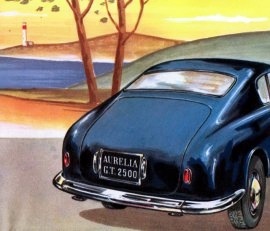 |
|
 |
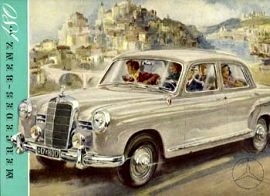 |
|
 |
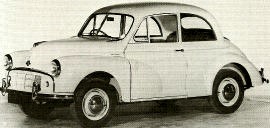 |
 |
Morris Minor Series II |
| |
Also see: Morris Car Reviews and The History of Morris (AUS Edition) |
| |
The Morris Minor Series II was available as two- or four-door Saloon and two-door Convertible. The arrival of the series II - unchanged externally from the preceding Series MM - heralded the switch from the old 918·6-cc side-valve engine to the smaller yet more powerful 803-cc OHV unit (similar to the Austin A30 engine but with an SU carburetor) - made possible following the merger between Nuffield and Austin (BMC) in the latter half of 1951. In October 1953 the Traveller Estate Car made its debut. |
|
 |
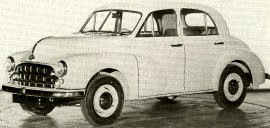 |
 |
Morris Oxford Series MO |
| |
Also see: Morris Car Reviews and The History of Morris (AUS Edition) |
| |
The Morris Oxford Series MO was available in Saloon and Estate Car (Traveller) variants. The latter had an ash-framed light alloy panelled body with sliding rear windows and vertically-hinged double back doors. Both the estate and saloon were fitted with a new chromium-plated radiator grille of different design to the zinc-alloy type used on previous Oxfords. |
|
 |
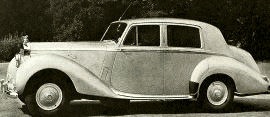 |
 |
Rolls-Royce Silver Dawn 4½-liter Saloon |
| |
Also see: Rolls-Royce Car Reviews | The History of Rolls-Royce |
| |
The Rolls-Royce Silver Dawn 4½-liter Saloon. First introduced in 1949-with the 4¼-liter engine-to meet the export demand for a 'smaller' version of the Wraith, it did not in fact become available on the home market until the autumn of 1953 by which time it had acquired the 4½-liter engine and the longer body of the R Type Bentley. |
|
 |
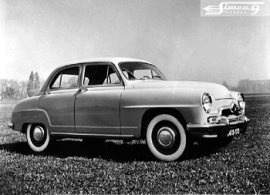 |
|
 |
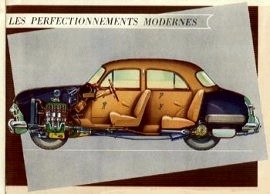 |
|
 |
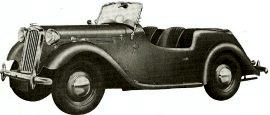 |
 |
Singer SM1500 Roadster Model 4AD |
| |
Also see: Singer Car Reviews | The History of Singer |
| |
The Singer SM1500 Roadster, Model 4AD, looked identical to the Singer Nine Roadster, but had a 1497-cc power unit and detail differences First introduced as an export-only model early in 1951, it did not become available on the home market until January 1953. During 1952 the width of the radiator grille slats was reduced and the pressure of the cooling system raised to correct earlier overheating problems. |
|
 |
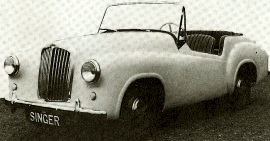 |
 |
Singer SMX Roadster |
| |
Also see: Singer Car Reviews | The History of Singer |
| |
The Singer SMX Roadster was an experimental plastic-bodied sports model, shown at the 1953 London Motor Show. Fitted with a twinncarburetor version of the 1½-Iitre engine, it was longer and lighter than the SM1500 Roadster which it was to replace. It did not get beyond the prototype stage, however, and this was the only one ever built. |
|
 |
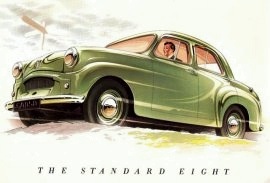 |
 |
Standard Eight |
| |
Also see: Standard Car Reviews | The History of Standard |
| |
The 1953 Eight was a completely new car with unit construction and an overhead-valve engine. Only saloon models were made. The new engine of 803 cc produced slightly less power than the outgoing larger sidevalve unit with 26 bhp at 4500 rpm but this was increased to 30 bhp at 5000 rpm in 1957. The 4-speed gearbox, with synchromesh on the top three ratios, was available with optional overdrive from March 1957. Girling hydraulic drum brakes were fitted. |
|
 |
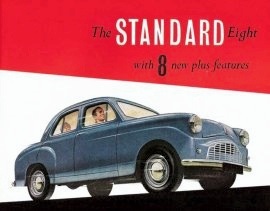 |
 |
Standard Eight |
| |
Also see: Standard Car Reviews | The History of Standard |
| |
To keep prices down, at launch the Standard Eight was very basic with sliding windows, single windscreen wiper and no external boot lid. Access to the boot was by folding down the rear seat which had the backrest divided in two. The 1954 De luxe got wind up windows and the Gold Star model of 1957 an opening boot lid. From mid 1955 all the Eights finally got wind up windows. At launch the car cost £481 including taxes on the home market. An example tested by The Motor magazine in 1953 had a top speed of 61 mph (98 km/h) and could accelerate from 0–50 mph (80 km/h) in 26.5 seconds. A fuel consumption of 43 miles per imperial gallon (6.6 L/100 km; 36 mpg-US) was recorded. |
|
 |
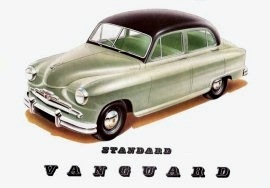 |
 |
Standard Vanguard II |
| |
Also see: Standard Car Reviews | The History of Standard |
| |
The Standard Vanguard Phase II Saloon, Series 20S. This extensively modified version was announced in January 1953. External changes included complete restyling of the back of the car, deletion of the lower of the three radiator grille cross bars, extension of the grille to take in the side lights, and the fitting of a bullet-shaped bonnet ornament. Mechanical modifications were made to engine, clutch, steering and suspension. The Phase II Estate Car variant appeared in February. |
|
 |
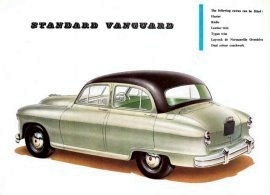 |
 |
Standard Vanguard II |
| |
Also see: Standard Car Reviews | The History of Standard |
| |
The Phase II Vanguard was of a contemporary Ponton, three-box design "notch-back" design. Boot/trunk capacity increased by 50% in comparison to that of the Phase I, and visibility was improved with a further enlarged rear window. Mechanically there were few changes but the clutch changed from cable to hydraulic operation and the engine compression ratio increased to 7.2:1. The previously fitted anti-roll bar was no longer used. Wider 6.00x16 tyres were fitted to improve road holding. |
|
 |
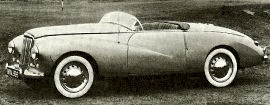 |
 |
Sunbeam Alpine Mark IIA Sports Roadster |
| |
Also see: Sunbeam Car Reviews | The History of Sunbeam |
| |
The Sunbeam Alpine Mark IIA Sports Roadster was named after the tough international rally in which the Sunbeam-Talbot 90 had been so successful. Introduced in March 1953, the Alpine was initially available only for export, most of them going to America. It was based on the 90 mechanically but with differences such as a tuned version of the 2267-cc engine, strengthened chassis and suspension, modified gearbox ratios and a straight-through silencer. The entirely new two-seater body was similar in general outline to the 90 Convertible but was immediately distinguishable by its louvred bonnet top and long rear decking. Either a single-pane windscreen plus side panels, or a curved transparent-plastic racing screen could be fitted; both are shown. |
|
 |
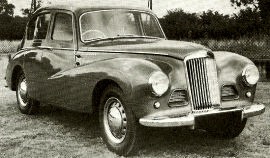 |
 |
Sunbeam-Talbot 90 Mark IIA Saloon |
| |
Also see: Sunbeam Car Reviews | The History of Sunbeam |
| |
The Sunbeam-Talbot 90 Mark IIA Saloon. Modifications introduced on this version-announced in September 1952-included perforated disc wheels with new chrome hub caps and rim embellishers, the deletion of the rear-wheel spats and the fitting of larger brakes. The Convertible version was similarly modified. |
|
 |
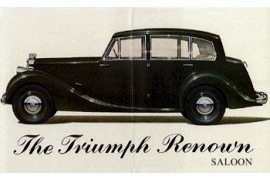 |
|
 |
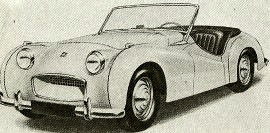 |
 |
Triumph Sports Prototype Model 20SR |
| |
Also see: Triumph Car Reviews | The History of Triumph |
| |
The Triumph Sports (prototype, Model 20SR) was the forerunner of the Triumph TR2, and was first shown at the 1952 London Motor Show. The two-seater bodywork featured a rectangular open air-intake at the front, long front wings and a short rounded tail on which the spare wheel was mounted; it was supported by the fuel tank filler pipe. Luggage space was very limited. Only two were built. |
|
 |
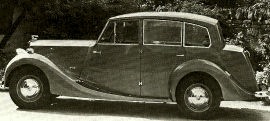 |
 |
Triumph 2000 Renown Saloon Model 20ST |
| |
Also see: Triumph Car Reviews | The History of Triumph |
| |
The Triumph 2000 Renown Saloon, Model 20ST, had superseded the similar-looking 1800 Saloon (18T) in 1949 and was continued in production until 1954- 1955. It had attractive knife-edge body styling and during October 1951 - 0ctober 1952 a Limousine version had been available. The latter had 3-in longer wheelbase (9 ft 3 in) and from early 1952 this size was adopted also for the Saloon (20STA). |
|
 |
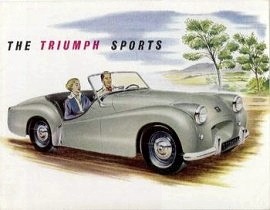 |
 |
Triumph TR2 |
| |
Also see: Triumph Car Reviews | The History of Triumph |
| |
The Triumph TR2 (Triumph 2 liter sports) was built between 1953 and 1955 by the Standard Motor Company in the United Kingdom, during which time 8,636 cars were produced. The DVLA revealed in 2002 that only 517 examples of this car remain on UK roads. The car used a twin SU carburetor version of the 1991 cc four-cylinder Standard Vanguard engine tuned to increase its output to 90 bhp (67 kW). The body was mounted on a substantial separate chassis with coil-sprung independent suspension at the front and a leaf spring live axle at the rear. Either wire or disc wheels could be supplied. The standard transmission was a four-speed manual unit but overdrive was available on top gear as an option. Lockheed drum brakes were fitted all round. |
|
 |
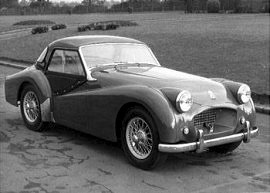 |
 |
Triumph TR2 |
| |
Also see: Triumph Car Reviews | The History of Triumph |
| |
A TR2 with overdrive tested by The Motor magazine in 1954 had a top speed of 107.3 mph (172.7 km/h) and could accelerate from 0–60 mph (97 km/h) in 12.0 seconds. A fuel consumption of 34.5 miles per imperial gallon (8.19 L/100 km; 28.7 mpg-US) was recorded. The test car cost £900 including taxes. The overdrive option had added £56 to the total. They also commented that it was the lowest price British car able to exceed 100 mph (160 km/h). |
|
 |
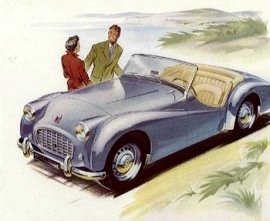 |
|
 |
 |
 |
Wolseley Four-Forty Four Saloon |
| |
Also see: Wolseley Car Reviews | The History of Wolseley (AUS Edition) |
| |
The Wolseley Four-Forty Four Saloon was a replacement for the Four- Fifty (1948-53) and featured a 1250cc OHV engine which developed 46 bhp at 4800 rpm, unitary construction, coil-spring IFS, and dimensions that made it longer, narrower and lower than its predecessor, although the wheelbase was the same. |
|
|
